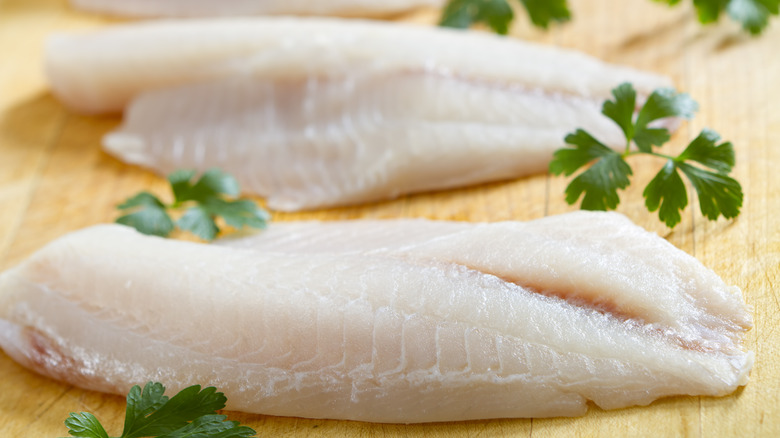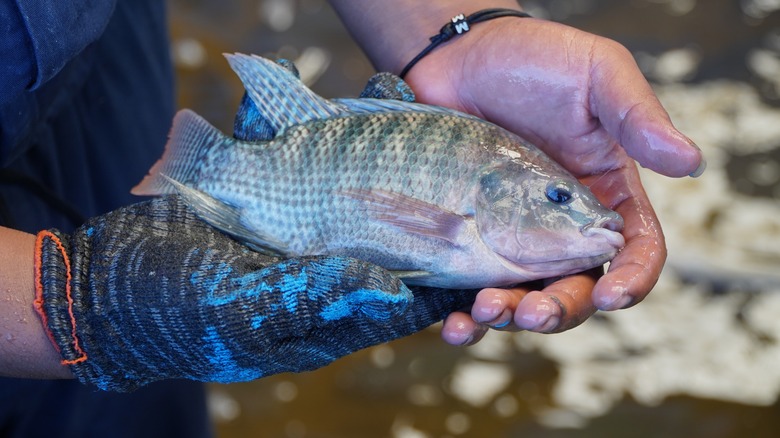Is Tilapia Really A Garbage Fish?
The online debate about tilapia is endless. Did you know that it's a fish that's pumped full of hormones and fed its own waste? No, wait, it's an environmentally friendly and sustainable mild fish that can carry many flavor profiles and works well in a variety of dishes. With fans and critics either singing its praises or bashing it, one must ask the question: Is tilapia really a garbage fish?
The more accurate assessment might be that tilapia is a misunderstood fish – here's what you should know before you eat tilapia again. First, the basics: Tilapia is a freshwater fish that is native to Africa and the Middle East but is now farmed globally, most commonly in Central America, Asia (especially China), and also in the United States. It's a white, flaky fish with a mild flavor (not super "fishy" in taste). In 2021, it ranked as the fourth most-consumed seafood in the United States according to the National Fisheries Institute, with Americans eating just over a pound of it per person yearly (equating to around 346 million pounds in total).
So, if Americans eat so much of this fish, then why the skepticism? Most of the complaints about it can be traced back to two key arguments regarding its treatment and taste. Critics bemoan that tilapia are farmed in poor conditions, kept in overcrowded tanks, and fed their own waste. But is there any truth to these allegations? Let's find out.
Tilapia's bad rap
Many people consider tilapia to be dirty or unhealthy because of the erroneous belief that it is farmed in poor conditions and fed poop. Scientists with Monterey Bay Aquarium's Seafood Watch put those rumors to bed and told The Washington Post that, although manure may be used to fertilize algae and plankton in the ponds tilapia are kept in, it's not used as food for the fish (although such a method would be the definition of sustainability if contamination issues weren't a concern). One USDA report cited by the Post from 2009 asserted that in Chinese tilapia farms, livestock droppings were eaten by the fish, but a Seafood Watch expert said they weren't aware of that ever being the case.
If you're still skeptical yourself, Seafood Watch actually maintains a list of safely farmed tilapia, as well as which tilapia to avoid, in order to help shoppers ensure that what they are consuming is safe for their health. The conservation program recommended buying tilapia farmed from Colombia, Indonesia, or Taiwan and yellow-rated, ASC-certified tilapia from Mexico.
The other main tilapia grievance has nothing to do with how they're farmed. Tilapia tends to get attacked by chefs who feel its mild flavor profile is uninspired. Chef Bob Kinkead, who owns and operates two restaurants in Vienna, Austria, once told The Washington Post that tilapia is "insipid," "spongelike," and "inferior." "Not in my restaurant," he told the publication. "Never sold it, won't sell it." Yikes.
The benefits of tilapia
It's not all bad. Tilapia is listed among fish with the lowest mercury levels, which makes it a safe option for regular consumption. It also boasts a handful of health benefits, making it a popular choice for those on the hunt for a healthy and versatile protein source. Speaking of protein, it's jam-packed. There's an estimated 26 grams of protein per 3.5-ounce serving, and it's also super lean, so it's a good option for those who want the protein without the fat.
Tilapia is also a good source of essential nutrients such as vitamins B12 and D, phosphorus, and selenium. These minerals are believed to play crucial roles in maintaining overall health, from supporting heart health to reinforcing the immune system and preserving bone health. Although tilapia is not as high in omega-3 fatty acids as some other types of fish, it's still a nutritionally solid choice.
Finally, it's incredibly versatile. This fish can be grilled, sautéed, baked, or broiled, and it makes frequent appearances in fried fish sandwiches, too. It's a flexible choice to incorporate into a variety of dishes. Because of its neutral taste, it pairs well with a pretty wide range of seasonings or sauces. And it's easy on the wallet, which many people appreciate.


